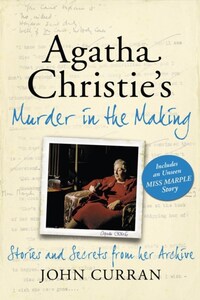Cover
Title Page
Dedication
Preface
Introduction
1 Rule of Three
2 The First Decade 1920–1929
Unused Ideas – One
3 Favourite Stories and ‘The Man Who Knew’
4 The Second Decade 1930–1939
Unused Ideas – Two
5 ‘How I Created Hercule Poirot’
6 The Third Decade 1940–1949
Unused Ideas – Three
7 Miss Marple and ‘The Case of the Caretaker’s Wife’
8 The Fourth Decade 1950–1959
Unused Ideas – Four
9 Agatha Christie and Poison
10 The Fifth Decade 1960–1969
Unused Ideas – Five
11 The Dark Lady …
12 The Sixth Decade 1970–1976
Unused Ideas – Six
13 Agatha Christie’s Booklists
Appendix 1: Agatha Christie Chronology
Appendix 2: Alphabetical List of Agatha Christie Titles
Index of Titles
Acknowledgements
Copyright
About the Publisher
Victoria Station, March 1931
Although she is by now an experienced traveller, the sights, sounds and even smells of the great railway station never fail to excite her. This is the start of her journey and she takes a moment to savour the sense of anticipation that bustling railway stations have always engendered in her – harassed and luggage-laden passengers hurrying along platforms, imperious-looking porters issuing instructions and shouting to invisible colleagues, the great trains snorting and bellowing clouds of smoke. She walks purposefully along the continental platform and hails a porter. As soon as she is installed in her seat she has an opportunity to observe, at her leisure, her fellow passengers. She can’t help speculating about the life of these strangers with whom she is to share a few hours in close proximity. This covert observation has, by now, become almost an occupational hazard and provided she is left to her own devising it’s all potential material. Now let’s see …
The moth-eaten looking man sitting opposite … studying his railway timetable and jotting down the details as he turns the pages could be … an office worker planning his holiday? a Civil Servant checking a business trip? a salesman plotting his sales route? His only luggage is a smallish case … probably for his samples … too small for encyclopaedias … brushes, perhaps, or … pens or … hosiery?
And that very handsome young man opposite … reading … what, exactly? It’s not a book … or a magazine … it seems to be typed pages, loosely bound, printed on only one side of the page and laid out very specifically. And he is studying it intensely and underlining sections of it … a business report? A manuscript perhaps and he’s correcting it? No … the corrections seem too regular. Ah, I’ve got it – it’s a script and he’s marking his lines … he’s an actor and that makes sense … matinee-idol good looks.
The older, haughty-looking woman in the far corner … seems to be waiting for someone, as evidenced both by her exasperated demeanour and by the continual checking of her wristwatch and her scanning of the platform for … her husband? No … no wedding ring … a friend, maybe … a travelling companion?
A harassed-looking older woman, struggling with a fox terrier on a lead and carrying a suitcase, a handbag, an umbrella and an assortment of magazines, hurries along the platform. In response to an imperious gesture she clambers into the carriage, managing to drop the magazines as she does so. Any lingering doubt as to her status is removed by the recriminations which follow.
Yes, definitely a companion … almost certainly a paid companion … nobody else would accept that sort of abuse.
At last, to the accompaniment of final shouts and whistles, the train glides out of the station and passengers settle down for the journey. As London begins to disappear her thoughts turn to the reunion ahead of her in a few days. Although married six months ago she has not seen her husband for almost four of those months. And despite a constant flow of letters in both directions she is anxious that, when they finally meet again, there should be no awkwardness. She knows that the best remedy for worry is work and she can easily and unobtrusively do some here where she sits.
And goodness knows, there is no shortage of potential material; just look around this carriage … and I want to get down that idea about Ruth Draper … very clever performance … complete transformation in a few seconds … must take lots of practice and endless rehearsals … which also reminds me …
Reaching into her bag, she produces a small, black-covered notebook. She opens it, idly noting that Rosalind has already tried to appropriate it by the simple expedient of writing her name and address on the inside cover – ‘Rosalind Christie, Ashfield, Torquay, Devon’. A further search produces a fountain pen. Unscrewing the top of the pen, she opens the notebook, flattens the pages and begins to read what she has already written.
Ideas 1931
Book
Poirot and a crime
a closed circle – one of them did it – he knows which – but now …








